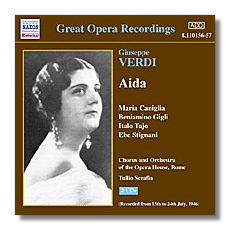
The Internet's Premier Classical Music Source
Related Links
- Verdi Reviews
- Latest Reviews
- More Reviews
-
By Composer
-
Collections
DVD & Blu-ray
Books
Concert Reviews
Articles/Interviews
Software
Audio
Search Amazon
Recommended Links
Site News
 CD Review
CD Review
Giuseppe Verdi

Aïda
- Maria Caniglia (Aïda)
- Beniamino Gigli (Radamès)
- Ebe Stignani (Amneris)
- Gino Bechi (Amonasro)
- Tancredi Pasero (Ramfis)
- Italo Tajo (Il Re)
Chorus of the Rome Opera House
Orchestra of the Rome Opera House/Tullio Serafin
Naxos 8.110156-57 ADD monaural 2CDs: 78:07, 62:34
This was not the first Aïda on records, but it was the first to feature the kind of star-studded casting that we expect in this opera today. In was recorded in July 1946 by Italian HMV, and released on forty 78-rpm sides by that company, as well as by English HMV and American RCA Victor. A later reissue on the budget-priced Seraphim LP label made this recording accessible to collectors with good taste or a skinnier wallet. It also was reissued fairly early in the CD era by EMI Classics. In short, since it was recorded more than 55 years ago, this set has been familiar and seldom (if ever) out of the catalogue.
Beniamino Gigli made eight complete opera recordings in the years immediately before, during, and after World War Two. This was the last of the eight. The tenor was 56 at the time, and a trifle patrician for the role of the impetuous young Egyptian commander, at least on stage. While his voice was fresher in the previous decades, there's little vocal deterioration here to speak of, and he does both himself and the role justice. Youthful idealism and romantic passion combine in this portrayal. Gigli sometimes took expressive liberties with the music, but he is relatively well-behaved here, although I could live without his scooping from note to note, especially in the Tomb Scene.
Gigli is surrounded by a largely excellent cast. Maria Caniglia is the most problematic, however. Her voice sounds good when she doesn't force it, so her quieter moments are best. Elsewhere, she suffers from stridency, wobbling, and intonation problems. Still, this is a dramatic and very Italianate interpretation, and Caniglia's Aïda is no fading Ethiopian flower, but a tigress in her own right. As Amneris, Ebe Stignani has the vocal security that Caniglia lacks, but not her temperament. Hers is a solid voice, and this is a good portrayal that would have been even better had Stignani's voice been richer and her personality more animal-like. Gino Bechi's Amonasro is superb, pity-inspiring in the Triumphal Scene, and cruel in his Act Three manipulation of Aïda. Basses Tancredi Pasero (Ramfis) and Italo Tajo (The King) anchor the ensemble with impressive authority. Serafin's conducting is full of theatrical savvy. In the tradition of Toscanini, his leadership nevertheless lacks the unrelenting intensity shown by his more famous countryman. To be honest, I appreciate Serafin's willingness to relax from time to time.
It is amazing how much lower frequency information has been retrieved in this digital remastering. The restoration was done by Ward Marston, who has used RCA Victor shellacs for this set, finding them quieter than their HMV analogues. Compared to the Naxos, the sound on the EMI Classics reissue mentioned above (CHS 7 63331 2) is boomy, and muffled by what might have been transfer engineer Keith Hardwick's adding of resonance. This is especially noticeable in full orchestral and choral passages. The Naxos, then, is superior.
The booklet contains brief comments on the recording. There is no libretto. Instead, a useful track-by track synopsis is provided. Collectors wanting their first Aïda should get one with a full libretto (and in modern sound), but this inexpensive new remastering of a classic recording will be welcomed by anyone who wants to delve more deeply into Verdi's score, or into the way singing used to be, not so long ago.
Copyright © 2001, Raymond Tuttle


















